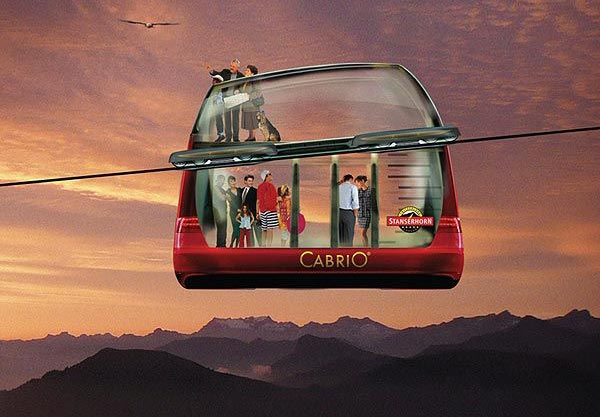This is the Stanserhorn Cabrio, a planned system for a mountain resort in Luzern, Switzerland. The system is not yet built (clearly) but the community is hopeful that they can raise enough money through local shareholders to make it happen.
(That last part about ‘community’ and ‘local shareholders’ should catch your attention, but I’ll get to that another day.)
So here’s the question:
If you can double your capacity on an Aerial Tram by building a double-decker vehicle, could you not also do the same on other cable technologies? How about on a 3S or Funitel? Doing so would increase maximum capacity of aerial systems up to 10-12,000 pphpd, which is enormous compared to most medium capacity technologies. It would be a game changer.
Doubling the height of transit vehicles isn’t so strange a concept. It’s common practice on commuter rails, buses and even on streetcar trolleys in Hong Kong.
I can’t imagine any essential reason why such a configuration couldn’t be accomplished. Double Decker gondolas would likely have a impact on station design, but that shouldn’t render the concept impossible. Furthermore, as vehicles are not the major cost of a system (nor the major load), doubling system capacity via Double-Deckering (let’s pretend that’s a word, okay?) should only result in a marginal increase in cost.
One of the things I truly love about cable is its flexibility and adaptability. It’s as much an art as a science.
Check out more pictures of the CabriO.



12 Comments
Double Decker gondolas would likely have a impact on station design
I’d think so. When the vehicles are small to begin with, you don’t want to sacrifice space for stairs between the decks. So you’d make the stations double decker, and then everyone can guess which deck to stand on to have the most space in the next gondola.
Furthermore, as vehicles are not the major cost of a system (nor the major load)
Really? I mean, sure, if you’re building small enough vehicles and spacing them far apart, but if you’re pushing the capacity limits of the technology I find it hard to believe vehicles would not be a large part of the load of the system. How closely spaced can the vehicles be? How many feet of cable equal the weight of a large double decker gondola?
Good point about the stations. My gut says that actually putting stairs between the decks makes most sense for exactly the point you make about “guessing” which deck to stand on. It would also reduce the station cost, even if it did result in a minor reduction in space.
There’s a bizarre irony with cable: the weight of the cable is always more than the combined weight of the vehicles/passengers being propelled by it. I know of no situation where the reverse isn’t true (though I could be wrong about that, I’ve just never heard of a situation where that fact isn’t true). That doesn’t mean that vehicle weight is not important, it just means that it is a factor that’s very much after the fact.
As for how many feed of cable would equal the weight of a large double decker gondola? I have no idea. You have to factor in the type of cable, the design of the gondola, the grip mechanism and the load. There’s too many factors for a back-of-the-envelope estimate. You also have to factor in what type of system. If it’s a 3S where there are 3 cable’s involved, are we talking the combined linear feet or are we just talking about a single foot of a single cable?
There’s a bizarre irony with cable: the weight of the cable is always more than the combined weight of the vehicles/passengers being propelled by it.
So I guess a follow-up would be, is this because the cable size has to grow right along with the weight of the cars/people it’s suspending? Because if that’s the case, the weight of the cars matters a lot.
I believe you for existing gondola systems; I’m just wondering what limits you might start to hit in a high capacity urban system.
I guess a 3S system like peak-2-peak would be an interesting starting point, or perhaps a system with larger gondolas. Do you know the weight of a loaded car and of a combined linear foot (or meter) of cable?
Eric (sorry I didn’t address your question sooner),
Again, the weight issue is really a case-by-case basis. Rope weight will be determined by a whole host of factors and there’s no real way to give a generalization on that point. Cable size doesn’t necessarily have to grow with the weight it’s suspending. Remember: Something like the 3S uses two ropes for support and one for propulsion. The propulsion rope is providing no support whatsoever.
Actually it is better to have double the number of the vehicles with half of the weight. The load is then distributed more evenly on the cable. Therefore double decker gondolas do not make much sense as spacing between gondolas could be reduced if needed. Double decker gondolas would also need higher mast for the same clearance as well taller stations etc.
Aerial Tramways have only two vehicles which should be as large as possible. And for mountain resorts there is also a marketing effect of having a double decker aerial tramway or a rotating gondola
Matthias:
I think my challenge is this: Could you have the same number of vehicles, but use a double-decker configuration in order to double system capacity? Having half the vehicles as double decker or twice the vehicles single story doesn’t really change the total capacity of the system. I think it important for the industry to push their technology forward in order to demonstrate to people that capacity is not a concern.
The peak2peak has a capacity of 2050 pphpd with cabins departing all 49 seconds. Per cabin there are 22 seated and 6 standing passengers. with more standing passenger and cabins leave every 10 seconds a 3S could beat streetcars and buses easily with 10000 pphpd or more. I really don’t think capacity is a main concern. More worries are things like accessibility. For a modern urban system gondolas would have to make a full stop to let people board and alight the gondolas.
Double decker also defy the principle of having many small vehicles instead a few big ones. I think the 30 person Gondolas on some 3S or Funitel system have a decent size. If larger vehicles i rather would make them longer with more doors to speed up boarding. Also the larger the infrastructure the more opposition it will have to face.
Matthias:
Long vehicles are a little more complicated to implement with cable (at least in an aerial configuration). It’s too complicated to explain here (maybe I’ll do a post about it later) but the deceleration/acceleration mechanisms currently preclude such a concept, though I doubt it’s a technological impossibility.
I agree completely that capacity’s not an issue, but people are funny. They hear “gondola” and they think “too slow, can’t carry enough people.” It doesn’t matter whether it’s true or not, people just tend to believe what they want to believe and there’s not too much you can do about it.
http://www.lift-world.info/en/lifts/1134/datas.htm
Or some more details, although in German: http://www.bergbahnen.org/forum/viewtopic.php?f=2&t=893
Look at the double deck cabin in Samnaun, Switzerland, made by Gangloff it holds up to 180 ppl.
http://www.myswitzerland.com/en/the-first-double-decker-cableway-in-the-world.html